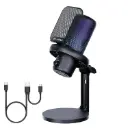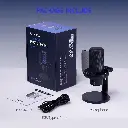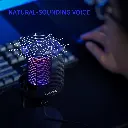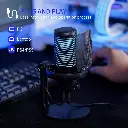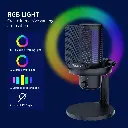Here’s a full spec & feature summary for the FEELWORLD VM1 USB Gaming Mic, what people like about it, its limitations, and whether it’s a good option — based on recent and reliable source info. If you want, I’ll also list what comparable mics cost locally so you can consider alternatives.
🔍 Specifications & Features
From FEELWORLD’s official listings + authorised dealers:
| Spec | Details |
|---|---|
| Capsule Type | Condenser, ~14 mm dia. feelworld official store+2B&H Photo Video+2 |
| Polar Pattern | Cardioid (focuses on sound from front, reduces side/rear pick‑up) feelworld official store+1 |
| Sample Rate / Bit Depth | 48 kHz / 24‑bit audio feelworld official store+2B&H Photo Video+2 |
| Frequency Response | ~ 50 Hz ‑ 16 kHz feelworld official store+2Throne+2 |
| Sensitivity | Around ‑40 dB ± 2 dB (0 dB = 1V/Pa, at 1 kHz) feelworld official store+1 |
| Maximum SPL | ~ 110 dB SPL feelworld official store+1 |
| Signal‑to‑Noise Ratio (SNR) | ~ 100 dB feelworld official store+1 |
| Output Impedance | ~ 2.2 kΩ feelworld official store+1 |
| THD + Noise | < 1% total distortion plus noise (THD+N) feelworld official store |
| Interfaces | USB‑C plug‑and‑play; also 3.5 mm headphone jack for monitoring feelworld official store+2B&H Photo Video+2 |
| Controls & Extras | |
| • One‑click Noise Cancellation (ENC) green LED when active. feelworld official store+1 | |
| • Mute touch button (toggles mute + RGB light to red). Throne+1 | |
| • Multifunction knob to control volume; long/short presses for switching modes (mic/headphone) or changing RGB lighting. Throne+1 | |
| Included Accessories / Mounting | Stand options: desktop stand, or variants with boom arm; shock‑mount and pop‑filter included in some bundles. B&H Photo Video+2B&H Photo Video+2 |
✅ What It Does Well
Looks good / fits gamer / streamer aesthetic: RGB lighting, mute light indicator, etc. Feels more premium than basic USB mics in terms of “look & control.”
Decent specs for the price: 24‑bit / 48 kHz is good; 110 dB SPL gives you some headroom; cardioid pattern + ENC help reduce ambient noise.
Plug‑and‑play is a strong plus: USB‑C connection, real-time monitoring via 3.5mm jack, low‑latency usage (as per listings) makes it easy to use with PC / Mac.
Multiple variants: desktop stand / boom arm options; color options (white / pink / black) give flexibility for matching setups.
⚠️ Limitations / Things to Watch Out For
Frequency tops at 16 kHz. This is fine for voice / streaming etc., but you lose some of the very high “air” detail that more premium mics with 20+ kHz response have.
Noise Cancellation (ENC) likely works only up to a point. Heavy ambient noise, fans, keyboard clicks etc. may still come through, depending on placement, gain settings.
As with many USB condenser mics, you’ll get more background / room noise if the room isn’t treated (echo, reflections etc.). Mic placement is crucial.
Sensitivity is fairly low (‑40 dB), so if you are far from mic or speaking softly, you’ll need to raise gain, which can increase noise.
Build / durability: being a fairly budget‑to‑mid‑range mic, the build may not be as rugged; cable quality, switch quality etc. might vary unit to unit.
The ENC + mute + RGB controls likely consume some power / electronics that can introduce a bit of complexity (possible noise or issues over time).
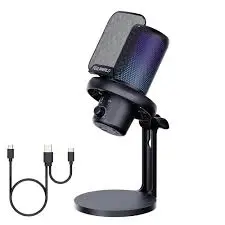
💡 Verdict: Is It Good for You?
If I were advising:
Good choice if you are a gamer / streamer / content creator looking for a mic under moderate budget, want ease of use, nice aesthetics, some noise control, and decent sound without needing to buy a separate interface.
It’s especially valuable if you already have a decent desktop setup, want to clean up your voice audio a lot vs using the built‑in mic, and want something with mute + RGB candles etc.
But if your focus is highest possible voice fidelity (e.g. podcasting, voice over, studio recordings), or if you're recording in very noisy / reverberant rooms, then spending a bit more or choosing a dynamic mic that rejects ambient noise more strongly might give better results.
